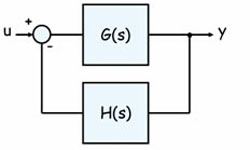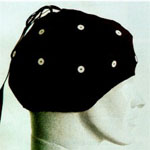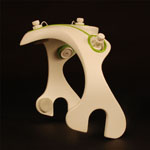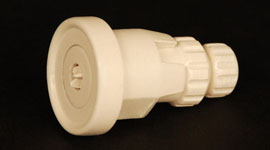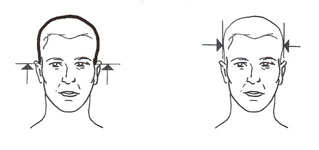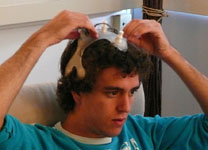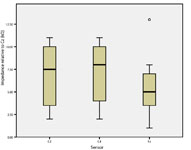CITEULIKE: 2328848 | REFERENCE: BibTex, Endnote, RefMan | PDF ![]()
Aart, J. v., Klaver, E., Bartneck, C., Feijs, L., & Peters, P. (2008). EEG Headset For Neurofeedback Therapy - Enabling Easy Use in the Home Environment. Proceedings of the Biosignals - International Conference on Bio-inspired Signals and Systems, Funchal pp. 23-30.
EEG Headset For Neurofeedback Therapy -
Enabling Easy Use in the Home Environment
Department of Industrial Design
Eindhoven University of Technology
Den Dolech 2, 5600MB Eindhoven, NL
design@joran.eu, e.r.g.klaver@student.tue.nl, c.bartneck@tue.nl, l.m.g.feijs@tue.nl, p.j.f.peters@tue.nl
Abstract - In this article we present the design of an EEG headset together with the context and vision that motivated us to undertake the described design work. There is a variety of potential advantages and potential difficulties associated with neurofeedback therapy. Both are analyzed informally and we argue in favour of a change in perspective, moving away from treatment of illness towards prevention and giving the user an active and responsible role. To structure the discussion we will deploy the closed loop diagram. We identify elements from the world of gaming that will have added value over a pure training approach, notably elements that improve enjoyment and motivation. We describe several of the design steps of the headset that has been designed to achieve enjoyable neurofeedback therapy in the home environment and conclude with an evaluation of this headset.
Keywords: Headset, neurofeedback therapy, electroencephalography, EEG, brain waves, home environment, wellbeing, impedance measurement
Introduction
With neurofeedback therapy we can make brainwave patterns explicit by for example a computer screen, patterns we normally cannot influence since we are unable to see or feel them. This feedback provides us the ability to influence and change them. With neurofeedback therapy we are literally reconditioning and retraining the brain (Hammond, 2007).
In order to provide a structure and discuss the wide variety of potential advantages and potential difficulties associated with neurofeedback therapy, we start by introducing the closed loop diagram of Figure 1. In this diagram, G(s) is the user, patient, sportsman, etcetera and H(s) is the external training equipment together with services of the therapist. To give an easy biofeedback example, let u be a desirable value for the BMI (Body Mass Index) and let y be the patient's or user's weight. Then H includes the calculation y/(length2), but also a display function. By informing the user of the difference between desired and actual BMI, the user is supposed to eat and move wisely and adjust his weight. This example actually has been realized as the Smart Mirror by Philips Electronics (Van Splunter, 2002).
Figure 1: Closed loop diagram with user G(s) and training equipment and services H(s)
Feedback theory has been the backbone of mechanical and electrical engineering since almost a century - and it still is. It is outside the scope of this article to try and develop precise models of the controlled system and the feedback function, we just use it to structure the debate. One remark is in order: it is of the utmost importance to be aware of the complexity of the human mind-body system G(s). Its subsystems include the skeletal, digestive, muscular, lymphatic, endocrine, nervous, and cardiovascular, urinary and reproductive systems. The nervous system includes the brain and its higher functions such as perception, cognition, and control. The subsystems are not only coupled, they also have internal feedback loops. This being said, we can begin.
Open questions
In this section we begin with some preliminary observations and open questions regarding neurofeedback (NF). Some of the questions are speculative and possibly controversial. We take them as a source of inspiration; several of the issues embedded in these questions will be addressed more seriously in the subsequent sections.
Neurofeedback therapy (Evans, 1999) is about training the mind in a non-intrusive way using EEG signals, stimulating or discouraging certain brain functions. Experiences with neurofeedback therapy might seem promising, however for some reason it hasn't been adopted by the general public yet. One of the causes might be that in present day society, there seems to be a tendency to focus on the physical aspect of health and on curing the symptoms rather than fighting the cause. For example, people with ADHD are drugged with Ritalin, which reduces symptoms of hyperactivity, but doesn't cure it. In contrast, the main focus of neurofeedback is on mental issues.
Another problem might be that neurofeedback therapy is based on a ‘mind over matter' perspective, implying that physical and mental wellbeing are interconnected (Fox, 1999; Kendell, 2001). However, for some reason it seems difficult to accept this perspective. Prejudices have been formed, perhaps as a result of the natural fear of the unknown. Still, although neurofeedback therapy has shown to have a positive influence on numerous disorders (Lubar, 1995), proof of absence of possible side-effects has not been supplied yet. Whether this is a potential issue for the therapy not to be accepted, remains open for debate. However, it has been said that if some or another medication could be as broadly and effectively applicable as neurofeedback therapy, it would already be available at every pharmacy in the world. (Roskamp, 2007). Maybe we should focus on a vision in which neurofeedback therapy could eventually become as easy as taking an aspirin.
Professional athletes use neurofeedback to improve their already exceptional performances by entering a state of ‘relaxed focus', a moment of optimal performance reached by this so-called peak-performance training. This raises the question whether neurofeedback could actually be applied to elevate our general wellbeing in the way athletes do. Heinrich et al (2007) formulate the following promising statement: ‘In addition, ‘normal' subjects may improve cognitive functions (e.g., attention and working memory) and performance in real-life situations by means of NF'.
Analysis
EEG products are mainly distinct in the number of electrodes that are used for measurements. Products range from the ElectroCap with 19 sensors (Figure 2) (ElectroCap International Inc., 2004), to two-channel products only using 2 sensors and clips on each earlobe. However, in either case scalp contact is optimized by removing dead skin cells and parting hair out of the way. Conducting gel is applied in most cases, although products with dry sensors are being developed as well. Recent products include the g.EEGcap (Guger Technologies OEG, 2007) and other techniques for measuring, like Project Epoc (Emotiv Systems Inc., 2007) and SMART BrainGames PlayStation System (SMART BrainGames, 2007).
Figure 2: ElectroCap (image courtesy of ElectroCap International Inc., 2004)
Referring to Figure 1 we decompose both G(s) and H(s) to identify various difficulties and opportunities. This also allows us to position our own contribution, which includes the design of the headset reported in section 5.
First we consider H(s), consisting of (1) the services provided by the therapist and (2) the training equipment. There are several good reasons why the therapist is involved. These include the professional judgment on the needs and on the progress of the patient, checking for counter-indications together with the personal attention and motivation given to the patient by the therapist. But at present the therapist is also needed to (a) position the EEG cap or headset onto the patient's head, (b) add conducting gel and (c) set-up the equipment. The latter reasons a-c, although indispensible at present, form at the same time a bottleneck. They are a bottleneck in the following sense:
- the therapist gets involved only after the user has been diagnosed to be ill or has been classified according to a certain disorder. The user has become a patient. In other words, feedback training is not used as a preventive tool, which could help a user to maintain a healthy equilibrium;
- the therapist is needed to take care of positioning the cap, applying conducting gel and setting-up equipment, in other words: without the therapist the neurofeedback training cannot happen. The user cannot train at home. This limitation in turn, limits the number of training sessions, both in frequency and duration;
There is one conclusion which we draw immediately, namely that if the practical difficulties related to the cap, the gel and the equipment can be solved or relieved, home usage and preventive usage are much more likely to happen.
But the contribution of the therapist is larger. There is no substitute for his or her professional judgment and personal attention. So the therapist keeps a role, although perhaps not during each session. This leaves a question about the unsupervised sessions. The question is how the user will keep him or herself motivated to train regularly. Our answer is simple: training should be fun. Phrased differently, there have to be motivational elements built-in to the training equipment (gaming, flow). We shall address this in the next section.
Now let's have a closer look at the user. G(s) is an intertwined mind-body complex. The output of the training equipment enters the user through suitable interface elements first at his or her bodily level: ears, eyes, perhaps touch. This is not very problematic because excellent interface elements such as loudspeakers, earphones, video screens etc. are readily available. There is also no lack of pleasant and aesthetic audio-video content. The user's output, the EEG signal, is also wiretapped at a physical level. This is a source of difficulties, as already mentioned. That is why we consider the design of an easy-to-use headset to be an essential step.
At a higher level inside the user there are processes of perception, cognition, volition and consciousness going on. It is at this level that issues of attention and attention deficit become noticeable, as in ADHD. But it is also at this level where fun, beauty and motivation occur.
Practical and motivational elements
To enable neurofeedback training in the home context, the product should be designed according specific requirements, aiming at improving the training methods and enabling users to operate independently. These requirements should include the ability to (a) easily locate sensor positions, (b) apply sensors and gel without help, (c) measure electrode impedance and to act accordingly and (d) easily clean and reuse the system.
Bringing neurofeedback training to the home environment would also benefit the financial aspect, reducing the cost of training as a result of decreasing expert involvement. Furthermore, only an EEG measurement device and software would have to be acquired, since we can assume that most households already have a computer.
In addition to the requirements, the training software should be intrinsically motivating (playful) (Rauterberg, 2004) as mentioned before. For designing training software, we formulated the following assumptions based on observations and experiences:
- A1: that it is helpful to give the user rewards based on performance;
- A2: that it is helpful to simulate elements from an assumed context of use;
- A3: that it is helpful to provide the user with quantitative performance data.
Taking a closer look at these assumptions, we find several opportunities to apply concepts of gaming to the proposed neurofeedback training software, for example:
- reward schemes with levels, credits, bonuses, etc. (A1);
- sound generation and rendering of high-resolution real-time environments (A2);
- statistics and graphs etc. (A3);
Acknowledging this overlap and the fact that intrinsic motivation is found in gaming (Malone, 1980), implies stimulating concentration and motivation. We suggest to incorporate gaming aspects in neurofeedback training software (e.g. ‘Brainball' of Hjelm (Hjelm, 2003) is considered to be an interesting example).
We aim for neurofeedback training applied in such a practical and motivational way that it can be considered a game. In the next section we describe the creation of a product in which we applied the aforementioned shift from treatment to play, in an attempt to show it is not only desirable but also achievable. However, we have to consider the fact that the rich media and gaming experience people are used to, has its influence on the expectancy for neurofeedback software; we could say that neurofeedback training has to keep pace with gaming.
Development of eeg headset
In order to reach the aims as discussed earlier, we developed a headset which gives the user the opportunity to retrieve EEG signals from his scalp in a convenient way. Combined with neurofeedback in the form of a 3D environment, this headset is the first step to the vision that combines gaming, EEG signals and therapy within the home environment. In contrast to the traditional ElectroCap, the headset (Figure 3) can be put on the head with ease and without professional help. Operations as locating contact points, attaching sensors and applying conducting gel are all integrated in the headset, enabling neurofeedback applications for non-expert users in the home environment. The product includes a headset, electronics, sensors, hard- and software.
The headset has a flexible construction to adapt to a variety of head dimensions. The material flexibility enables a one-size fits all design, reckoning with a head breadth variety of 1.3 inch. This figure is based on difference in dimensions of children age 6 (5th percentile girls, 5.1 inch) to adults (95th percentile male, 6.4 inch) (Woodson, Tillman, & Tillman, 1992). The mechanical properties of the material make sure that the headset is stable on the head, which is necessary for the sensors to work properly. Soft cushion pads on the sides provide the headset with more stability and comfort.
Embedded electronics take care of the 2-channel EEG signal amplification, enhancing signal strength. Two sensors (positioned on points C3 and C4 of the international 10-20 system) measure EEG signals while the sensor positioned on the Cz location acts as a ground (a common reference electrode placement). The fourth sensor is placed near the Fz position and acts as an active electrode, according to the ‘driven right leg' (DRL) principle (Webster, 1998) to minimise distortion. This position has been chosen for its symmetric location relative to points C3 and C4, preventing topographic distortion. Moreover, it increases the stability of the headset by restricting the headset to tilt when nodding or moving the head otherwise.
The sensors (Figure 4) can be clicked in and out of slots in the headset. Those slots enable two degrees of freedom (translation and rotation), enabling the sensors to adapt to different head shapes and dimensions autonomously. A flexible material between the sensor and the headset allows for vertical sensor translation and applies a force, pushing the sensor on the scalp. Additionally, the shape of the sensor slots enables a 20 degree rotation to both sides. The combination of translation and rotation assures that the sensors can adapt to different head shapes and helps to maintain a stable signal.
The detachable sensors measure EEG signals on the scalp. Therefore the scalp has to be scratched in order to gently remove dead skin cells that disturb the signals, this is achieved by simply twisting a part of the sensor called ‘scratcher'. Furthermore, a container for conducting gel is implemented in the scratcher. The gel can simply be applied by pushing a plunger. By doing so, the gel connects the tin (Sn) electrode with the scalp, bridging the gap caused by the hair. Currently, the sensors need to be filled with gel using a syringe, but in the future gel capsules or disposable sensors will be developed to nullify this inconvenience.
The 2 channel EEG signal retrieved from the sensors is magnified by the analogue pre-amplifier in the headset. This signal is converted using an A/D converter, which is located in an external box. The box also contains a power source and an opto-coupler for safety reasons. The signal is send to a computer, which feeds the retrieved bio-signals back through a 3D environment. This 3D environment includes different sessions for neurofeedback training, where the user learns to train specific brain capacities using goals and instant brain feedback (e.g. the intensity of a fire is related to the level of concentration, see Figure 5).
Figure 5: Screenshot of 3D environment 'AdventurePark'
Evaluation
To test the quality of the headset, we developed an initial functional prototype since the actual headset has not been manufactured yet. This prototype was used in an evaluation of the headset principle.
Research Question
An impedance limit of 5 kohm is often mentioned for clinical use of the EEG, in order to prevent signal distortions (Heinrich, 2007). In this project however, we allow ourselves a 10 kohm impedance limit because of two reasons. Firstly, we assume that the distortion level depends on the length of the wires, which is reduced by embedding the preamplifier in the headset. Secondly, the embedded DRL system filters a lot of distortion, ensuring a relatively high quality EEG signal. This leads to the following formulation of the research question:
All sensors of the headset have impedance lower than 10 kohm when placed on the head of the participants.
Method
We conducted an experiment in which we compared the impedance values of the sensors against the requirements of 10 kohm.
Apparatus and Measurements
To prevent for extreme cases influencing the reliability of the experiment, head dimensions of the participants have been measured by the experimenters (Figure 6). A tape measurer has been used to measure the ear to ear distance along the skull (from the points of attachment of the ears along the centreline of the international 10-20 electrode placement system). For the head breadth, measured straight above the ears, a self-made sliding calliper has been used (Figure 7).
Figure 6: Head dimension measurement method
Figure 7: Self-made sliding calliper
The impedance of the sensors C3, C4 and Fz were measured relatively to sensor Cz. For this, the 2-Channel EEG MindSurfer Standard hardware has been used. The value was determined by reading an analogue gauge implemented in the Jukebox mental training software installed on a notebook (NEC Versa P520). The gauge was calibrated on forehand with resistors with fixed values.The functional prototype (Figure 8) was made of 4mm thick Plexiglass and shaped according the headset design.
Participants and Procedure
Twenty students (17 male, 3 female, age 20-24) participated in this test. The tests took place in an cutoff room. After welcoming the participants, they were asked to sit in a comfortable chair.
Figure 8: Picture user test participant
After a short introduction the participant was asked to put on the headset. The experimenters assisted in positioning the headset and parting the hair out of the way. Participants gently scratched their own head with the sensor scratchers and applied the gel. The participants were able to see the impedance value on the notebook screen and were instructed to optimise the conductance by trying to bring this value down to less than 10 kohm. They were told to achieve this by using the sensor scratchers and by shaking the headset slightly, allowing the gel to settle. After optimising the conductance for about one minute, the researcher recorded the impedance value of each sensor. This value indicates the impedance between sensor Cz and sensors C3, C4 and Fz. 2-Channel EEG hardware was used, whereas three values had to be recorded. Therefore the C3 sensor wire was connected to the Fz sensor after recording its value, the C4 wire was disconnected at that time. After each test, all gel was removed from the sensors and new gel was inserted, to ensure the same conditions for all participants.
Results
We calculated the mean and standard deviations of all measurements and report on them in Table 1 and illustrate them in Figure 9. A t-test showed that the mean impedances for C3 (t(19)=-4.616, p<.001), C4 (t(19)=-4.082, p=.001) and Fz (t(19)=-7,452, p<.001) were significantly lower than 10 kohm. The head dimensions of the participants are within the 5th and 95th percentile as defined in the Human Factors Design Handbook (Woodson et al., 1992).
| mean | std dev | |
| Head breadth (cm) | 15.01 | 0.52 |
| Ear to ear distance (cm) | 31.75 | 1.40 |
| Sensor C3 (kohm) | 6.70 | 3.20 |
| Sensor C4 (kohm) | 7.10 | 3.18 |
| Sensor Fz (kohm) | 5.40 | 2.76 |
Table 1: Head dimensions and sensor impedances
Figure 9: Median, quartile ranges and outliers of result set
Conclusions
Based on the results of this evaluation we can state that the functional prototype reaches impedances significantly lower than the desired 10 kohm limit. In addition, based on our experience there seem to be some aspects that would probably decrease the impedance even more, although it should be mentioned that no extensive testing of these aspects has been done. Firstly, based on our own experience, it seems that having some experience with the headset plays an important role in creating good conductivity. Given a certain amount of training, most users are likely to achieve impedance levels below 5k. Secondly, the impedance measurements were recorded after approximately one minute of having the gel applied on the head, yet our experience gives the impression that the impedance tends to decrease a bit over time.
The results are considered promising and in manufacturing the headset, there should be aimed for the same characteristics as the functional prototype. However, this doesn't imply that the manufactured headset will actually behave in the exact same way and therefore we propose an evaluation of the final product as well.
Discussion
We identified several possible issues holding back the development and implementation of neurofeedback therapy. New aims of neurofeedback are suggested, including: 1) a focus shift in healthcare from cure to prevention, 2) increasing the focus on mental wellbeing in healthcare, 3) elevating the standard of living by enabling users to consciously train brain signals 4) implementing gaming approaches in neurofeedback to increase intrinsic motivation.
In an attempt to make neurofeedback training more accessible by combining the therapy with gaming in the home environment, we designed a headset that can be used all by oneself in combination with a 3D gaming environment for desktop pc. We evaluated a prototype of the headset and proved that the impedances of the sensors were significantly below 10 kohm. Of course, future work will have to imply the actual realization and testing of this headset, more iteration steps will have to be made before starting large volume production.
To our knowledge, this headset is one of the first attempts to apply enjoyable neurofeedback in the home environment. It can be used without supervision of a medical expert and can be operated by a single user, lowering the practical barriers of neurofeedback therapy, combined with motivational elements in the form of an entertaining 3D game. Hopefully, this will increase the societal acceptance of neurofeedback
We argue to continue developing headsets implementing EEG sensors, in order to stimulate the ease of use. Future work could include gel capsules to prevent hassle with syringes and cleaning, or even dry EEG sensors. Furthermore, a focus should remain on using gaming as motivational tool in neurofeedback therapy and to support society adopting neurofeedback training to increase overall mental wellbeing. Neurofeedback therapy already exists for over a decade; still the general public is unaware of the broad spectrum of opportunities neurofeedback could provide. Curing mental illnesses is of course a big opportunity, but neurofeedback has the potential to go much further. Instead of curing, it could prevent mental illness to happen or even exceed current human capabilities. For this to be realized, the neurofeedback research community should focus on practical and motivational issues that hold back the implementation of neurofeedback therapy, and create a shift towards a society that greatly benefits from its possibilities.
Acknowledgements
We would like to thank Joep Frens, Chet Bangaru, Jacques Terken and Geert van den Boomen from the Department of Industrial Design, Eindhoven University of Technology, who helped shaping our thoughts and enabled the design of the headset. Furthermore we would like to thank Geert-Jan Driessen, Pierre Cluitmans and Frans Tomeij for sharing their knowledge and insights on the matter. The Mind Connection in Maastricht has been a contributor of the project.
References
ElectroCap International Inc. (2004). ElectroCap International Inc. Retrieved April 3, 2007, from http://www.electro-cap.com
Emotiv Systems Inc. (2007). Project Epoc. Retrieved July 13, 2007, from http://www.emotiv.com
Evans. (1999). Introduction to quantitative EEG and neurofeedback.
Fox, K. R. (1999). The influence of physical activity on mental well-being. Public Health Nutr, 2(3A), 411.
Guger Technologies OEG (2007). g.EEGcap. Retrieved July 13, 2007, from http://www.gtec.at/products/Accessories/gEEGcap.htm
Hammond, D.C. (2007). What is neurofeedback. Journal of Neurotherapy, 10(4), 25.
Heinrich, H., Gevensleben, H., Strehl, U. (2007). Annotation: neurofeedback - train your brain to train behaviour. J Child Psychol Psychiatry, 48(1), 3-16.
Hjelm, S. I. (2003). Research + design: the making of Brainball. interactions, 10(1), 26-34.
Kendell, R. E. (2001). The distinction between mental and physical illness. Br J Psychiatry, 178, 490.
Lubar, J. F. (1995). Evaluation of the effectiveness of EEG neurofeedback training for ADHD in a clinical setting as measured by changes in T.O.V.A. scores, behavioral ratings, and WISC-R performance. Biofeedback Self Regul, 20(1), 83.
Malone. (1980). What Makes Things Fun to Learn?: A Study of Intrinsically Motivating Computer Games. Ph.D. dissertation, Department of Psychology, Stanford University.
Rauterberg, M. (2004). Positive effects of entertainment technology on human behaviour. In Rene Jacquart (Ed.), Building the Information Society (pp. pp. 51-58): IFIP, Kluwer Academic Press.
Roskamp, H. (2007, feb/mar 2007). Wordt baas in eigen brein. Bright, 14, 57-61.
SMART BrainGames (2007). SMART BrainGames PlayStation System. Retrieved July 13, 2007, from http://www.smartbraingames.com/product.asp?id=1289
Splunter, J. van (2002). Building Technology for People. Retrieved October 29, 2007, from http://ww5.newscenter.philips.com/assets/Downloadablefile/CEBIT-Asia-Keynote-speech-Van-Splunter(1)-3734-1440.pdf
Webster, J. G. (1998). Medical Instrumentation (3rd ed.). New York: John Wiley & Sons.
Woodson, W. E., Tillman, B., & Tillman, P. (1992). Human Factors Design Handbook (2nd ed.): McGraw Hill.
This is a pre-print version | All Publications
